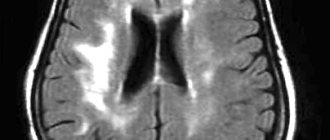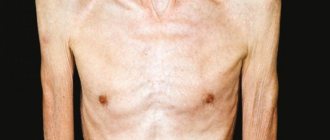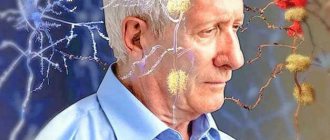Reasons for the development of Friedreich's ataxia
The development of the disease is associated with an imbalance of intracellular iron; its high concentration in mitochondria causes an increase in free radicals that destroy the cell. An imbalance occurs when there is insufficiency or distortion of the structure of a protein synthesized in the cytoplasm - frataxin . This protein is responsible for the transport of iron from mitochondria, and when it accumulates above normal levels, a decrease in cytosic iron occurs.
These are the main reasons for the development of Friedreich's ataxia, as a result of which genes encoding ferroxidase and permease , which, like frataxin, are responsible for iron transport, are activated. This leads to even greater accumulation in the mitochondria. Heredity is caused by the so-called Friedreich's disease gene, presumably found in the centomeric region of the 9th chromosome at the 9ql3 - q21 locus. mutations can occur , which causes different forms of the disease. Friedreich's ataxia accounts for half of the cases of ataxia. The first signs appear before the age of 20, much less often before 30. It occurs equally often in both women and men; only representatives of the Negroid race are not affected by this disease
The disease affects the neurons of the central and peripheral nervous system, but medicine has no explanation as to why only the spinal cord pathways in the nervous system are damaged. In other systems, no less important organ cells are affected by the disease, these are myocardial cells, β - cells of the islets of Langerhanz in the pancreas, cells of the retina and bone tissue.
The course of the disease is constantly progressive. If there is no adequate treatment for Friedreich's ataxia, the duration of the disease does not exceed 20 years. And having begun to manifest itself as awkwardness and uncertainty when walking, dysarthria , after a while it completely deprives a person of normally coordinating movements and moving independently. The disease is fatal; in rare cases, in the absence of such manifestations as diabetes mellitus and heart disease, patients live up to 70-80 years.
Causes
Impaired frataxin synthesis leads to excessive iron accumulation and damage to nerve cells.
The disease is autosomal recessive in nature. This means that the development of the disease occurs if both the father and mother are carriers of the pathological gene. The mutation is located in the long arm of chromosome 9, resulting in disruption of the synthesis of the frataxin protein. This leads to an increase in iron content inside the mitochondria. A high concentration of iron promotes the formation of free radicals that destroy cell structures. The most sensitive to damage are the cells of the nervous system (mainly the posterior and lateral columns of the spinal cord, spinocerebellar tracts, sensory fibers of the peripheral nerves), myocardiocytes, the β-insular apparatus of the pancreas, rods and cones of the retina, and cells of the skeletal system.
Depending on the severity of the genetic defect, there can be both “classical” forms of the disease (with a pronounced mutation) and atypical, relatively benign syndromes.
Symptoms of Friedreich's ataxia
The first symptoms of the disease are suppression of the Achilles and knee reflexes. These symptoms appear several years before the appearance of others, and early manifestations include rheumatic carditis , which is often treated as a separate disease. So these are not considered to be symptoms of Friedreich's ataxia until neurological damage occurs. Gradual skeletal deformities occur, such as scoliosis, finger and toe deformities, and Friedreich's foot, in which there is abnormal extension of the fingers in the main phalanges and the foot has a high concave arch.
areflexia typical of ataxias . Muscular and vibration sensitivity, muscle hypotonia, and Babinski's symptom are impaired. cerebellar ataxia , atrophy and weakness of the leg muscles gradually develop
In 90% of patients, extraneural manifestations occur, these are heart lesions, endocrine disorders , cataracts . cardiomyopathy develops ; it can be either hypertrophic or dilated. In this case, symptoms of Friedreich's ataxia are observed, such as pain in the heart, palpitations, systolic murmurs, and shortness of breath . Endocrine diseases such as diabetes mellitus , hypogonadism , infantilism , and ovarian dysfunction .
The late stage of ataxia is characterized by amytrophy and a disorder of deep sensitivity, the disappearance of tendon and periosteal reflexes. Which extends to the upper limbs. A deep breakdown of motor functions occurs, causing a person to lose the ability to walk and take care of himself. Kyphoscoliosis develops with the formation of a hump and deformation of the hands. Extraneural manifestations may include nystagmus, hearing loss, optic nerve atrophy, dysfunction of the pelvic organs, and dementia . Progressive cardiomyopathy in the later stages of the disease is the cause of death in half of patients, most often due to disturbances in the cardiac wiring system. Direct causes of death also include pulmonary failure and infectious complications.
Symptoms
Clinical manifestations of the disease depend on the conditional form:
- Classic Friedreich's disease (typical form);
- An atypical form of Friedreich's disease (with a slight breakdown in chromosome 9).
For the first time, classical Friedreich's disease (typical form) can make itself felt at a fairly young age, usually up to 25 years, less often the disease has a slower rate of development, then the first signs appear in the fourth decade of life (atypical form).
The disease often manifests itself with damage to the lower extremities, gait disturbances and motor coordination disorders (based on ataxia, which is of a mixed nature, cerebellar-sensitive). The patient notes uncertainty when walking, unsteadiness of gait, even falling. Over time, disturbances in the movements of the upper limbs and trembling in them may occur.
Over time, other neurological changes occur:
- Weakness in the leg muscles, up to paresis and paralysis (at the same time, the knee and Achilles reflexes decrease and later fade away, but pyramidal signs may be detected);
- Violation of deep and superficial sensitivity;
- Development of hearing loss, optic nerve atrophy;
- Speech impairment (if the disease lasts more than 5 years);
- Decreased cognitive function.
Somatic (extraneural) manifestations in the clinical picture of Friedreich's ataxia are the following symptoms:
- Shortness of breath, rapid heartbeat, paroxysmal cardialgia (these symptoms are caused by the development of cardiomyopathy);
- Skeletal anomalies in the form of kyphoscoliosis, cavus foot (“Friedreich’s foot”);
- Ovarian dysfunction, hypogonadism, diabetes mellitus.
Taking into account the damage to various structures of the nervous system, as well as the involvement of other body systems in the process, for diagnosis it is customary to distinguish between mandatory signs, common signs, and rare signs.
Obligate (obligatory) symptoms of the disease include:
- The onset of the disease is before the age of 25 years.
- Progressive cerebellar-sensitive ataxia.
- Progressive loss of coordination in the limbs.
- Fading knee and Achilles reflexes.
- Decreased deep sensation in the legs.
- Dysarthria – jerky, slow speech.
Common, but not obligatory, signs of the disease include:
- Pathological Babinski reflex.
- Hollow foot.
- Kyphoscoliosis.
- Weakness, hypotrophy and atrophy of the muscles of the limbs.
Rare signs of Friedreich's ataxia:
- Optic nerve atrophy.
- Nystagmus.
- Sensorineural hearing loss.
- Postural tremor.
- Vertigo.
- Spasticity in the limbs.
- Moderate cognitive impairment.
The clinician should be alerted and directed to look for other diseases by the presence of the following signs: early manifestation of the disease (up to 2 years), severe cognitive impairment, the presence of extrapyramidal pathology syndromes, sensorimotor neuropathy, decreased speed of nerve impulse transmission along motor fibers, ophthalmoplegia.
It should be remembered that the atypical form of the disease is not characterized by: total areflexia, cardiomyopathies, endocrine disorders.
Diagnosis of Friedreich's ataxia
Computed tomography of the brain, which remains the main diagnosis of ataxia in this disease, is ineffective; a number of changes can be detected only in late stages. This is due to the spinal localization of changes, so it is possible to detect only a weak degree of cerebellar atrophy at an early stage and atrophy of the hemispheres, expansion of the stem cisterns, lateral ventricles and subarachnoid space of both hemispheres at later stages. Early diagnosis of Friedreich's ataxia is made using MRI , which makes it possible to detect atrophy of the spinal cord, and at an advanced stage, moderate atrophy of the pons, cerebellum and medulla oblongata. At the initial stage, an electrophysiological study is required; during such studies, the severity of damage to the sensitivity of the nerves of the limbs is established.
For a complete diagnosis, stress tests of glucose tolerance and x-ray examination of the spine are performed. First of all, diagnostics is aimed at accurately establishing a diagnosis and differentiating the disease from others with similar symptoms. For example, the symptoms of Friedreich's ataxia may be the same as those of hereditary ataxia due to vitamin E , Bassen-Kornzweig syndrome , hereditary metabolic diseases such as Krabbe disease and Niemann-Pick disease . Similar symptoms may occur with multiple sclerosis , with the exception of tendon areflexia, muscle hypotonia and extraneural manifestations. It is not typical for Friedreich's ataxia to have remissions and changes in the density of brain matter, which is observed in the diagnosis of multiple sclerosis.
To differentiate the disease, a number of additional laboratory tests are prescribed. DNA testing and medical genetic counseling, blood lipid profile examination, and blood smear analysis for the presence of vitamin E and acanthocyte . Treatment of Friedreich's ataxia does not lead to complete recovery, but timely prevention makes it possible to avoid the development of many symptoms and complications. Diagnosis of Friedreich's ataxia using DNA testing should be prescribed not only to the patient, but also to relatives to determine the heredity of the disease; this is necessary for the purposes of prevention and prescribing preventive therapy.
Friedreich's disease: treatment of pathology
Despite the fact that neurology as a science is currently quite well developed, this disease cannot be completely cured. This is due to the fact that it is caused by a genetic mutation that cannot be influenced. Nevertheless, doctors correct neurological disorders, making life easier for patients. Antioxidants (medicine Mexidol) and drugs to improve cerebral circulation (medicines Piracetam, Cerebrolysin) are used. These medicinal substances help slow down degenerative processes. To improve motor function, physiotherapy, orthopedic correction, and massage are performed. In some cases, surgical treatment is necessary (with significant curvature of the feet).
Diet, nutrition for Friedreich's ataxia
Diet for the nervous system
- Efficacy: therapeutic effect after 2 months
- Timing: constantly
- Cost of food: 1700-1800 rubles per week
Diet 9th table
- Efficacy: therapeutic effect after 14 days
- Timing: constantly
- Cost of products: 1400 - 1500 rubles per week
Low carb diet
- Efficiency: From 3 to 7 kg in 2 weeks
- Time frame: 14 days
- Cost of food: 1250-1320 rubles per week
Diet for diabetes
- Efficacy: therapeutic effect after 14 days
- Timing: constantly
- Cost of products: 1300-1400 rubles per week
Treatment methods
Like all hereditary diseases, treatment of Friedreich's ataxia is aimed at maintaining the quality of the patient's condition and stopping the development of pathology. Maintenance therapy allows the patient to not experience complications for a long time and to care for himself without outside help.
The main treatment consists of taking metabolic drugs from the following groups:
- antioxidants (vitamin A, E);
- stimulators of mitochondrial respiratory chain activity;
- cofactors of enzyme reactions: idebenone - a synthetic substitute for coenzyme Q 10 to slow down neurodegenerative processes or 5-hydroxypropane.
In addition, drugs are prescribed that improve the metabolic process in the heart muscle, nootropics, neuroprotectors, and multivitamins. In each specific case, the doctor selects the drug and dosage individually.
For muscle spasms, botulinum toxin is injected. In case of significant bone deformities, surgery is performed to correct the shape of the foot.
Exercise therapy and physiotherapy are one of the most important components of treatment. Regular exercises according to a program individually drawn up by a physical therapy doctor will allow the patient to maintain motor activity, muscle strength and restore coordination for as long as possible. Physiotherapeutic procedures help reduce pain and generally improve the condition.
Social adaptation is necessary, since patients with this diagnosis, due to deterioration of their condition, stop moving independently, see poorly, and do not coordinate their movements. Constant help is important not only from specialists, but also from family and friends.









